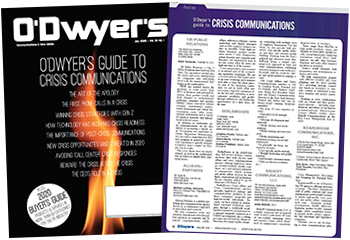 Ryan Colaianni Ryan Colaianni |
It’s no secret among communications professionals that news travels faster than ever. The cycle of news stories is getting shorter as a result, but with the spread of digital-native publications and the dominance of social media as a news source, there are also more ways for a crisis to gain oxygen.
This new environment also increases the number of stakeholders who expect to be heard or have a seat at the table when a crisis arises. From policymakers to consumers to employees and far beyond, your organization must be deliberate in addressing the different concerns and expectations held by each stakeholder audience.
Further, individuals are paying increased attention to how organizations respond to crises. The general public is in the driver’s seat, and their expectations have the power to shape responses and improvements for organizations experiencing a crisis.
 |
| This article is featured in O'Dwyer's Jan. '20 Crisis Communications Magazine. |
There’s no doubt that this has changed the crisis response playbook. Previously, audiences typically wanted organizations to simply acknowledge their wrongdoing and address the issue before moving on. But today, audiences not only want organizations to acknowledge their wrongdoing, they also want assurances that the organization has made appropriate long-term changes for the better, often outside of the scope of the original issue.
Just look at the story that broke in November about Google collecting personal health data in collaboration with a large hospital system, without notifying patients and physicians. This specific partnership went under the microscope of policymakers and resulted in additional scrutiny toward other acquisitions Google has made in the health space, such as Fitbit, and how the company plans to protect that personal data.
Google argued that its work “adheres to industry-wide regulations,” and that may be true, but stakeholders including data privacy experts, U.S. senators, consumer advocates and Google users called on the tech giant to go above and beyond the standard requirements and evolve its data collection practices.
This example illustrates that being properly prepared to respond to a crisis or issue has never been more critical. Regularly evaluating crisis response materials to ensure that staff clearly understand their roles and have participated in crisis communications simulations before an issue hits is now a requirement, not a luxury. Evolving scenario plans on a quarterly or even monthly basis to anticipate what areas of reputational risk may enter the public domain should be table stakes. Without it, you’ll be caught flat-footed when a crisis occurs.
In addition, response plans must go beyond a statement simply shared with the media. The Pew Research Center has chronicled the rapid rise of social media as the top news source for Americans over the last decade, and nearly 60 percent of Americans get their news from these sources today. Given that the majority of Americans are getting news this way, organizations have to tailor their messaging to social audiences. It’s imperative to think about how a response will be received online before determining a strategy for more traditional audiences.
Beyond the response itself, public expectations around response speed have also changed. The public now expects a response from organizations within minutes, not hours or days. Without a quick and strategic response to a crisis, your organization’s story will be told without your input, increasing the risk of long-term reputational impact.
So, what do these new, broader audiences want to know in the middle of a crisis? There are typically five questions that the public wants answered to ensure your organization is taking the issue seriously.
What happened?
While this question may seem straightforward, it is often challenging for organizations to understand what entirely occurred in time to develop and share a complete and accurate response quickly enough. And there is nothing worse than an organization providing an intentionally selective view of what happened, or worse yet, providing inaccurate information. While the initial response does not have to include the full picture, it must acknowledge the issue and provide a timeline for when more detailed information will be available in order to appease audiences temporarily.
Who’s impacted?
When navigating a crisis, your organization must clearly define the direct and indirect impact on various stakeholders and what it is doing to help those individuals. You must work from a broad scope and then work to narrow the impacted audiences as you consider each response.
What did you do when you found out?
Given that the public often does not learn of a crisis in real-time, the public will demand to know what your organization did when the spotlight was not on. Meaning, if the organization did little or simply ignored the crisis because there was no public awareness at the time, it will lead to increased reputational risk and additional demands from stakeholders.
What changes were made, and how are you going to ensure it doesn’t happen again?
Your key audiences want to know what specific improvements or measures the organization took as a result of this particular crisis. Accountability and action reassures the public that the crisis is being taken seriously and is an easy way to address stakeholder concerns.
How will you change for the better?
This question is often ignored when organizations navigate a crisis and is an overlooked opportunity following the response phase. Often, when organizations stop getting frequent media calls or hearing from stakeholders, they believe the crisis is behind them and move on. But your organization must be smarter than this by placing yourselves on a path for long-term recovery to rebuild trust. This means not only addressing the crisis directly via the questions above, but also facilitating broader change for the organization. For example, this could mean advocating for more substantial changes at the policy level or in industry standards, or it could mean a recommitment to your organization’s mission.
Proactively preparing for these questions ahead of time is essential to ensuring that you will address each issue adequately against the new demand for faster, better responses. After all, for large organizations, it’s no longer a matter of if a crisis will occur, it’s a matter of when.
***
Ryan Colaianni is a Senior Vice President and lead of the Issues/Crisis group at ReviveHealth, a full-service agency focused on the intersection of healthcare delivery, finance and innovation.


 There’s a fine line between newsjacking and taking advantage, aka ambulance chasing. Our job as PR professionals is to tread it carefully.
There’s a fine line between newsjacking and taking advantage, aka ambulance chasing. Our job as PR professionals is to tread it carefully. PR firms need to be mindful of ways their work product may be protected by the attorney-client privilege whenever working with a client’s internal legal team or its external legal counsel.
PR firms need to be mindful of ways their work product may be protected by the attorney-client privilege whenever working with a client’s internal legal team or its external legal counsel. Manuel Rocha, former US ambassador and intenational business advisor to LLYC, plans to plead guilty to charges that he was a secret agent for Cuba.
Manuel Rocha, former US ambassador and intenational business advisor to LLYC, plans to plead guilty to charges that he was a secret agent for Cuba. CEO mentoring is an often-overlooked aspect of why CEOs are able to make good decisions, and sometimes make bad ones—all of which intersects with the role and duties of a board.
CEO mentoring is an often-overlooked aspect of why CEOs are able to make good decisions, and sometimes make bad ones—all of which intersects with the role and duties of a board.  How organizations can anticipate, prepare and respond to crises in an increasingly complex world where a convergent landscape of global challenges, threats and risks seem to arrive at an unrelenting pace.
How organizations can anticipate, prepare and respond to crises in an increasingly complex world where a convergent landscape of global challenges, threats and risks seem to arrive at an unrelenting pace.


 Have a comment? Send it to
Have a comment? Send it to 
No comments have been submitted for this story yet.